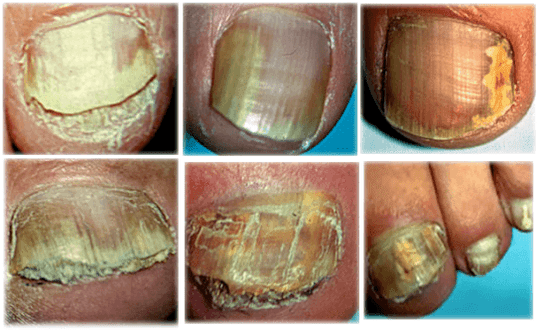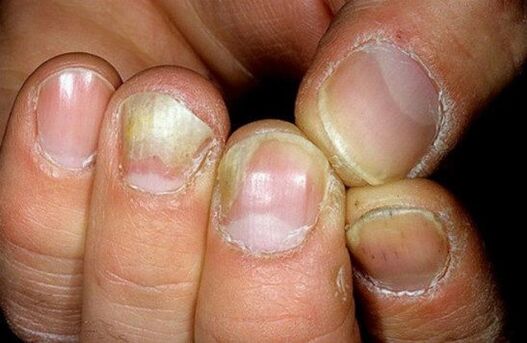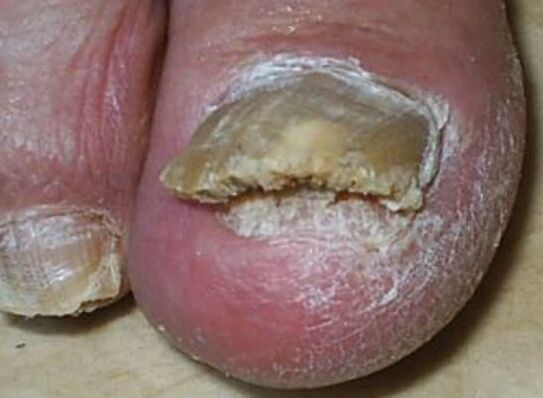Onychomycosis is an infectious nail disease caused by pathogenic fungi. According to statistics, it occurs in every tenth person on Earth. About one third of all nail diseases are fungal infections. More than 30% of cases occur in patients over the age of 65. Toenail fungus is 3-5 times more common than on the hands.
Causes of onychomycosis of the nails
The disease begins with nail infection, which often occurs in public places - swimming pools, saunas and baths. Stairs with pathogen spores fall to the floor, benches, walkways and carpets. Humid and warm environments allow fungi to survive and multiply, especially on unpainted wooden items. Wearing tight shoes increases the chance of infection.
If one of the family members is sick, there is a high risk of transmitting the disease through a towel, rug, or grill in the bathroom. The fingernails become infected mainly when the affected areas of the skin are combed. The risk of the disease increases with repeated nail injuries, decreased blood circulation in the extremities and with severe comorbidities (diabetes, AIDS, systemic blood diseases).
Symptoms and types of onychomycosis

There are three forms of the disease: atrophic (onycholitic), normotrophic and hypertrophic onychomycosis. The characteristic symptoms are:
- the appearance of white or yellowish spots in the thickness of the nail plate;
- inflammatory process in the periungual roller;
- atrophy of the nail with separation from the bed;
- dystrophic processes in the nail plate.
With atrophic onychomycosis, the nail plate becomes grayish-brown, atrophies and separates from the bed. Loose layers form on the exposed area. The hypertrophic form is characterized by subcutaneous hyperkeratosis, which causes pain when walking, changes in shape and destruction of the nails. The nails become dull and thickened. With normotrophic onychomycosis, the nail does not thicken and retains its luster. Stripes and spots appear on the nail plate, changing its color.
Nail fungus treatment
Onychomycosis begins to be treated immediately after diagnosis, as the infection develops rapidly. Therapy with local antifungal drugs is effective only in the initial stages. With the development of the disease, the use of systemic agents is necessary.
In order for the systemic treatment of toenail fungus to be safe and effective, several rules must be followed:
- Therapy can only be started after confirming the diagnosis and consulting a doctor, as antifungal agents have a number of serious side effects. Self-selection of the dosage is unacceptable.
- During treatment with systemic antifungals, the use of other drugs, except vital ones, should be limited.
- Affected areas of the nail should be removed after softening them with keratolytic patches.
- To prevent digestive disorders during the treatment period, foods that can cause bloating are excluded from the diet: black bread, dairy products, cabbage, legumes.
- You need to choose comfortable shoes that do not crush the foot.
Treatment of nail fungus at home
Traditional medicine offers several recipes for remedies that will help speed recovery, but they should only be used in conjunction with the main treatment.
- Treat the affected nails 2 times a day with a 5% iodine solution. A slight burning sensation should be observed during application. With severe pain, treatment should be stopped.
- To facilitate the separation of infected nails and promote regeneration, a 20% propolis tincture is used, which is applied to the lesions 2-3 times a day.
- Take a small piece of kombucha and attach it to your washed and steamed toenails. Leave overnight, remove in the morning, rinse with water and remove the softened areas of the nail. Treat affected areas with an antiseptic. The course of treatment is 2-3 weeks.
- Grate the head of garlic and make compresses, applying the gruel on the infected nails for 10-15 minutes.
Prevention and prognosis of onychomycosis of the nails
To prevent the disease, you should observe personal hygiene, do not use someone else's clothes, shoes and towels. In bathrooms, swimming pools and saunas, walk only in slippers, avoiding contact with places of potential accumulation of the pathogen (wooden pallets and carpets). It is necessary to wear comfortable shoes, avoid damage to the nails and fight excessive sweating of the feet.
The prognosis is favorable, depending on the severity of the disease, full recovery takes from a few weeks to a year. The effect of the therapy increases when the damaged nails are removed. Reinfection is possible if the rules of personal hygiene are not followed.
A photo




















